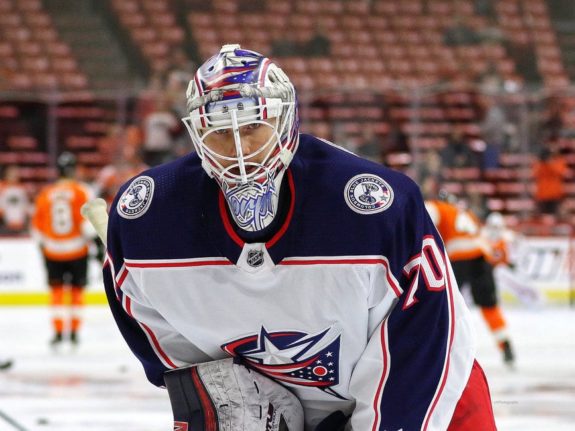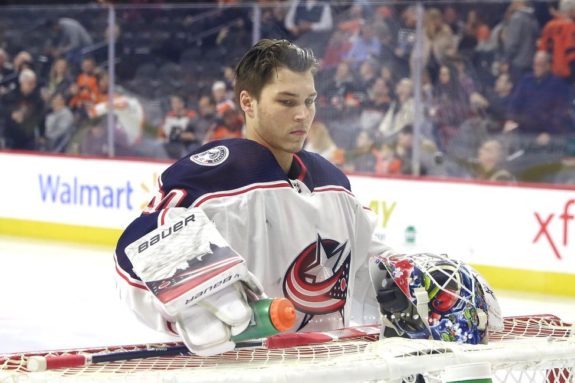Well, they did it. The underdog Columbus Blue Jackets knocked off the Toronto Maple Leafs in 5 games to earn a bid to the first round of the 2020 Playoffs. Because the play-ins were totally different from the playoffs. It was a series that lived up to the billing of a very stoppable force in Columbus’ offense against a very movable object in Toronto’s defense.
Before the series began, we discussed why the Blue Jackets defense, and particularly who they choose as their 6th defenseman, would be key in this series. It was, but it wasn’t the reason they won. Our Cody Chalfan highlighted a few of the key players that propelled the Jackets to victory, but we’re going to just talk goaltending and break down why the Jackets are moving on while Toronto goes home…or stays home? Vacates the arena and hotel.

Now, as a caveat- goaltending is voodoo and preposterously difficult to analyze and project into the future based on currently available public data, but that doesn’t mean it isn’t worth trying. There are a few things to note, though. First, goals-against average (GAA) is not a valid goaltending measurement, but rather a team statistic, and therefore I won’t use it in this piece.
Related: Blue Jackets: Revisiting the Artemi Panarin Trade
Instead, I’ll use a few other deeper, better stats: goals saved above average (GSAA) ((league save percentage * shots against) – goals against), essentially comparing goalie x’s saves to what a league average goaltender would save; and goals saved above expected (GSx) which is just expected goals against minus goals against, or shots saved that goalie should save based on shot quality and quantity. For further explanation and additional examples of more accurate measurements, check out Evolving-Hockey’s glossary page.
How Columbus Helps Their Goalies
Generally speaking, the Blue Jackets play a system that allows their goaltenders to thrive and makes their job much easier than it would be on other teams, as a certain Sergei Bobrovsky may have noticed this season. They limit their opposition’s shot opportunities, particularly in quality, keeping shots to the outside. In fact, their 510 5-on-5 High Danger Chances Against (HDCA) this year were 3rd least in the league. Plus, we know John Tortorella – the more blocked shots the better.
However, the Jackets defense wasn’t nearly as stout against Toronto and their high-octane offense. While their expected goals against (xGA) was 1.86, 8th best among the 24 playoff teams, their scoring chances against was the highest of any team at 146, as were their 48 HDCA. While these were down from the Leafs’ regular-season shot production, with numbers like that you can’t expect to get past a team like Toronto unless you get some big-time help in net, and the Jackets sure did. Their 5-on-5 on-ice save percentage was 97.89, 2nd highest behind Colorado.
The difference in this series was goaltending, but it wasn’t just the run-of-the-mill solid goaltending we’ve come to expect from Columbus goalies. This was a stunningly good performance in net from both Elvis Merzlikins and, surprisingly, particularly Joonas Korpisalo.
Korpisalo vs. Merzlikins
Going into the series, Korpisalo was named the starter, a decision that I strongly disagreed with. Merzlikins was the vastly superior goalie in the regular season and brought a confidence to the team I thought would be necessary. Also, although some people may be surprised to hear it, analytically Korpisalo was a below-average goalie, and not only this year – over the past 3 seasons, he’s allowed 27 goals above expected, 10th worst in the league.

During the regular season, Korpisalo’s .910 save percentage (SV%) ranked 38th in the league. His +43 GSAA ranked 37th and his -8.94 GSx was 67th among all 85 goalies who played at least 50 minutes this year per Evolving-Hockey. No matter which way you slice it, he wasn’t a strong starter, and you don’t need the numbers to tell you that. Watching Korpisalo, you saw a goalie who would make a fantastic save and then let in a muffin of a shot, a common problem for young goalies, but altogether not someone you want to rely on in the playoffs against Toronto.
Conversely, Merzlikins this year was 10th in SV% (.924%), 6th in GSAA (13.21) and 30th in GSx (.41). He was the benefactor of a particularly hot streak at the turn of the new year when he won 12 of a possible 14 games with a blistering .953 SV%, but that’s not a small sample size – he was who I thought should have been named starter.
But he wasn’t, and that worked out pretty well for the Blue Jackets. Merzlikins did nothing to change public opinions of him this series: His .946 SV% ranked 4th, 2.06 GSAA ranked 7th and .06 GSx ranked 14th among all goalies who played in the round robin and play-in rounds at all strengths. His 5-on-5 numbers were even better, since he was largely burned only at the end of Game 4 when Toronto brought on an extra attacker for a 6-on-5, and then subsequently had a power play in overtime to win it on an Auston Matthews one-timer. Merzlikins overall was excellent.
Related: The Good & the Bad: The Columbus Blue Jackets Under GM Scott Howson
However, he was overshadowed by Korpisalo, who was nothing short of dominant. Korpisalo’s .956 SV%, 3.76 GSAA and 3.2 GSx all ranked 2nd among all 25 goalies who played at least 50 minutes in these ‘playoffs’ thus far. He stopped the first 50 shots he saw in the series, including a robbery on Matthews right in front of the net. He became the 8th goalie in NHL history to record multiple shutouts in a best-of-five series, and the first since 1983. The only netminder who had a higher GSAA and GSx was Carey Price, who himself had quite the resurgence in the play-in round.

Between Korpisalo and Merzlikins, Columbus saved 6.8 goals above expectation against Toronto, an astronomical number to hit in just a 5-game series. They were helped by a 1.056 PDO, which is basically just really good puck luck, and an abysmal 2.02 5-on-5 shooting percentage from Toronto, by far the worst of the 24 teams. But make no mistake – this was an elite goaltending performance form both Columbus goalies, and in particular a level of play form Korpisalo we’ve never seen before.
Can it continue? Who knows. History says it’s unlikely, but as I mentioned at the top, goaltending makes absolutely no sense and performances continually surprise, so Korpisalo just might keep this rate up. You have to feel good for him, too – he waited a long time for his chance and man did he ever come through once he got it. Columbus will have to really lean on him though, as Merzlikins is out injured with no timetable given for a return, and a loaded Tampa Bay Lightning squad is on the horizon.
Ah, I’m sure Tampa will be too much, though. The Jackets don’t stand a chance, right?
All data used in this was from Evolving-Hockey and NaturalStatTrick.com, two excellent public sources for learning more about hockey analytics. Also, tweets are from Micah Blake McCurdy, Sean Tierney and JFreshHockey, fantastic sources for analytics and NHL analysis.